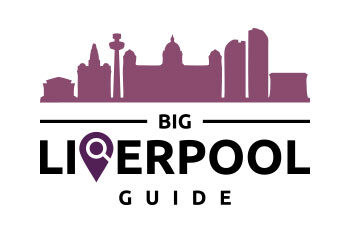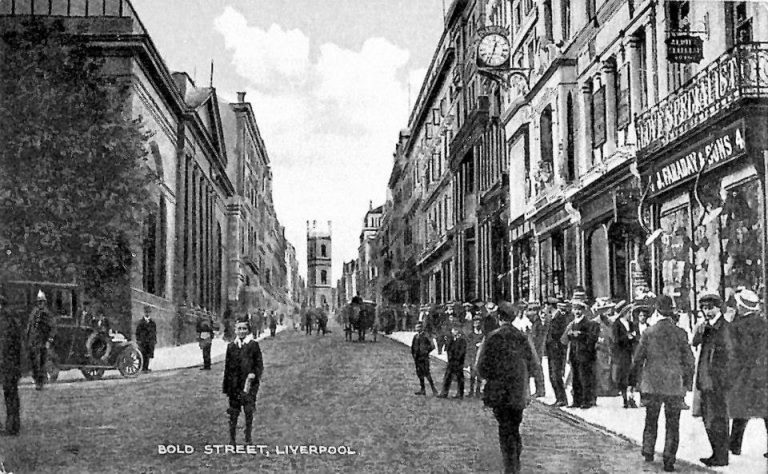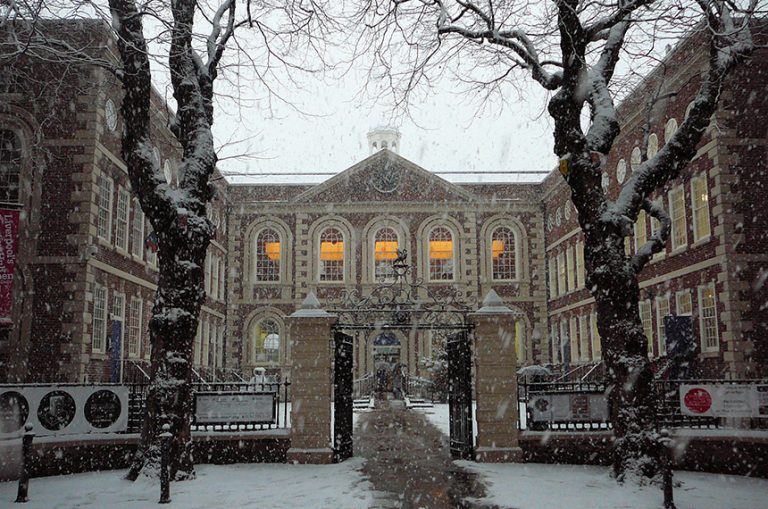300 Days of Celebrating the Bluecoat’s 300th Birthday
300 Days of Celebrating the Bluecoat’s 300th Birthday
In 2017 the city will be celebrating the 300th birthday of Bluecoat, Liverpool’s oldest city centre building and the UK’s very first dedicated art centre.
In honour of this great achievement, curator Bryan Briggs has disclosed details for a 300-day birthday celebration. An exciting programme set to include one exhibition, Public View which involves displaying work from an extensive back catalogue of artists that spans over 50 years. Another exhibition, My Bluecoat, will examine the history of Bluecoat and it’s long-term effect upon the city of Liverpool.
Opened as a School 1717
Initially, Bluecoat was opened as a school for:
“the promotion of Christian charity and instilling in needy children the principles of the Anglican Church, in the year 1717”
This Latin phrase still stands strong embossed upon a marble plaque in what were once the chairty school grounds – a steadfast reminder of the charitable nature of founders Reverend Robert Syth and Bryan Blundell, Master Mariner.
Orphaned children or those from families that had fallen on hard times were taught at Bluecoat. Students were schooled in skills linked to the shipping industry, as well as regular curriculum.
Bluecoat School adopted pioneering teaching techniques that gave pupils the best chance at a good start in life. The Madras teaching system, put forth by Dr.Bell, encouraged able pupils to assist teachers by sharing their knowledge with struggling classmates. It was this sort of forward thinking that attracted teachers from across the globe to Bluecoat learning and adapting to a new wave of mentoring.
The name Bluecoat was given to the school due to the colour of coats that students wore. The rich blue denoting the charitable origins of the institution. A popular spectacle was the annual St George’s day parade which took place in the courtyard and through the main gate of the school.
The Bluecoat school went on to thrive from the support of Liverpool residents. In particular, those that had once been pupils and were now wealthy from the education they had received at Bluecoat.
Due to this amazing support, the building was expanded by Blundell’s sons to accommodate 200 students and today there are still remnants of the rebellious students evident in 18th Century Graffiti found in the courtyard.
Eventually, in 1906 the school found a new residence in Wavertree, where it remains today.
History of the building
When the Bluecoat building was first commissioned total production costs totalled £2,300 (£40 million today). The identity of the architects who created Bluecoat was largely debated until recently with major names in contention including, Thomas Rigby, Thomas Steers and Henry Sephton.
After researching the meticulously kept records of Bluecoat’s finances, in 2016, the names of Thomas Steers and Edward Litherland cropped up alongside substantial payments. Steer’s and Litherland, a celebrated stone mason, therefore are the most likely pair to have designed and constructed Bluecoat. Having also designed the Old Dock and other buildings in the area together at the time.
After the school moved out, the building went unused until Sandon Studios Society rented a space after their original premises were demolished.
Following this, Lord Lever became the temporary landlord in 1909. Lord Lever had a strong interest in the arts, as evidenced in his model village Portsunlight on the Wirral and his collection in Lady Lever Art Gallery. This passion for the arts inspired Lord Lever to create an arts centre from the Bluecoat building. He renamed the building the ‘Liberty Building’, after a legal victory in a court battle but sadly, war broke out and the plans for the art centre were shelved.
After Lord Lever passed away, the building was not bequeathed to anyone in his will and was put up for sale. Bluecoat fell into further disuse and was threatened with destruction in the 20th century, after spending a short time as an automobile showroom.
In 1940 plans were put forward to destroy Bluecoat to make way for an inner city ring road, thankfully these plans fell through. Further threat to the Bluecoat during the Second World War came in the form of heavy fire damage but still remained standing strong.
Rejuvenation
There are some stunning historical features of the Bluecoat that add to the stunning beauty of the Queen Anne style facade. These include the cherub heads on the keystones, the first sculptural examples of Liver Birds on the fences and the eccentric one-handed clock all of which remain prominent features today.
Visitors to Bluecoat today can enjoy the result of an extensive renovation project that took place between 2005 – 2008. Designers carried out the rejuvenation to make Bluecoat more accessible to a modern day public whilst also retaining some interesting pieces of architectural history.
There are stripped back sections of cloisters exposing original 18th-century brickwork. The main entrance, or hub, has many focal points showing original historical features of the building. People can even dine in the Bistro that is located it what once was the Chapel where students attended regular sermons.
Today Bluecoat is a modern day arts centre and back in 1908 Sandon Studio Society members and Lord Lever himself could never have imagined the impact Bluecoat would have on the city of Liverpool.
A fine example of 18th-century philanthropy
Originally a school, then a home for struggling bohemians, the Bluecoat tells a powerful story of Liverpool’s charitable nature and how it has helped shape the city we know and love today.
The Sandon Society group were a collective of defected students from the University of Liverpool’s School of Applied Art and Design. In 1907 they rented studio space in Bluecoat to serve as creative space and living quarters. The group had new ideas of artistic expression that differed from the confines of conservative art schools and formed their very own independent art institution.
When Bluecoat was facing closure in the early 20th century, one member of Sandon Society group, Fanny Lister, spearheaded a public campaign to keep the Bluecoat alive. She appealed to the public to save Bluecoat and raised £12,000 in donations. An amazing example of Liverpool’s generous residents but falling short of the required £40,000 mortgage.
The saving grace of the campaign came in the form of a cheque from an anonymous donor who topped up the funds with a £18,000 donation.
William Ernest Corlett was later discovered to be said donor who, by chance, met an editor from the Echo in support of the campaign. Conversations with this person encouraged Corlett to save the Bluecoat with his substantial donation
Today the Voluntary Bluecoat Society stands as a testament to those involved with the arts centre since its inception.
Those who eat, sleep and breath art can donate their time and experience to Bluecoat; in return, they learn more about alternative artistic avenues.
A variety of programmes take place at Bluecoat today and encourage people to get involved in artistic expression. Innovative projects such as the Blue Room that is set up so disabled visitors have the ability to create and discover art in new and accessible ways.
The roots of Liverpool’s creative, artistic and philanthropic community can be traced back to the Bluecoat as the first ever UK Arts Centre made possible through the charity of the cities inhabitants.
300 days for 300 years
Over the course of 300 days Bryan Briggs, artistic director at Bluecoat, has curated a series of exhibitions showcasing the history and effect of the Bluecoat upon the artistic world.
The Public View exhibit will host a list of over 100 artists all of whom have previously shown work in the Bluecoat. This exhibition has been organised to bring attention to the diverse style of artists that have displayed their work at Bluecoat over the last 100 years. Returning artists include Dave Jacques and Bill Drummond among many others.
David Jacques: The Irlam House Bequest
During the exhibition taking place between 3rd of February – 23rd of April, admission is free and visitors can enjoy various pieces of work spanning across all forms of creative outlet. Some pieces having been specially adapted for the occasion.
A second exhibition, My Bluecoat, takes an in-depth peek at the interesting history that formed the Bluecoat we celebrate today. From charity school to the centre of Liverpool’s artistic and creative community, My Bluecoat will be taking visitors of the exhibition on a journey through time.
Accounts of individuals who were associated with Bluecoat in the early days have been gathered through the outreach of the project on social media. Their stories will form an alternative narrative detailing the recollected history of the building.
Individual accounts of those who have memories of attending Sandon Society events, some recalling times spent studying art with the group.
In recent history, Bluecoat has had a place in many Liverpool resident’s memory as a shop to buy their favourite chart-topping vinyl or even as an independent cinema screening cult films.
An important piece of Liverpool
Bluecoat receives over 60,000 visitors every year that come to experience an alternative artistic side of Liverpool. The building remains a home to creative businesses and cultural tenants which help keep the original bohemian artistic community and culture alive.
Over the course of three centuries, Bluecoat has stood fast, through the ever-changing fortunes of Liverpool the centre has provided and educational facility for the most vulnerable and needy people of the city. Bluecoat reaches out to children and families and remains dedicated to the support and nurturing of Liverpool’s creative talents.
Heavily involved in Liverpool’s LGBTQ community as well as hosting artistic celebrations in Liverpool Bluecoat has provided the city with the fabulous multicultural heritage it is famous for today.
On this the 300th birthday of Bluecoat, we look forward to learning about the strong influence the centre has had on the city and its ability to inspire charity in the people of Liverpool and the global artistic community.
Bluecoat and Arts
From Sandon Society’s occupation of Bluecoat in 1907 to present day, Bluecoat has been the home of Liverpool’s progressive art scene of 300 years.
The earliest exhibition hosted by Sandon Society in 1908 included work from Monet, Wyndham Lewis and Charles Rennie Mackintosh.
This fine art showcase was followed by masters of the trade in 1911. Works from Picasso, Matisse, and Van Gogh were displayed alongside Liverpool’s own local artists upon the very walls of Bluecoat.
What was once a simple artists studio had become a venue where the worlds of fine art were mixed in with the innovative and experimental. Bluecoat was now at the forefront of new and creative developments, responsible for launching new artists into the world and nurturing new talent.
The visions of Lord Lever and Fanny Lister had become a reality. Bluecoat was the centre of Liverpool’s creative community and “a place where the artistic bright people of Liverpool could get together with the clever and original”. Fanny Lister
In 1931 a majorly controversial exhibit came to the Bluecoat. Jacob Epstein’s ‘Genesis’ had shocked the world over, as was Epstein’s style to rebel against the pretty and ornate.
The sculpture drew crowds of nearly 50,000 through the doors of Bluecoat each paying sixpence a head.
This exhibit amassed a small fortune for Bluecoat, and highlighted the power of art to shock, yet also inspire and amaze.
Bluecoat flourished in 1960 with contemporary art exhibitions, musical, theatre and dance performances. Bluecoat connected Liverpool to a wider spectrum of art and took advantage of being the avant-garde venue in what had become fairly conservative art world.
Artists such as Yoko Ono and Jeremy Deller, Turner prize winner, have displayed their work at Bluecoat. As well as musicians Stravinsky, Bartok and Britten and jazz artists Sun Ra. Other performing artists include comedian Vic Reeves and dancer Michael Clark.
In the 1990’s Bluecoat began displaying work of mixed media, encouraging artists who were experimenting with painting and film. It was then that Bluecoat took to the streets and began reaching out to a wider community and involving the public in their productions.
A fixed and ever present force in Liverpool’s art scene, encouraging and supporting creative individuals. Bluecoat gives anyone who has a passion for art the chance to express themselves through creative channels.
Looking forward to another 300 years
The next 300 years
After resisting threats of demolition, surviving bombings, a blazing fire and the test of time, what’s next for Bluecoat?
It’s true that Liverpool’s creative heritage is rooted in Bluecoat. Ongoing festivals of today can trace their origin back to Bluecoat. Events such as the Arab and Asian Arts festivals started in Bluecoat in 1998 and with a strong partnership with Liverpool’s Biennial of Contemporary Art formed in 1999, we can expect to see a continued presence from them on the art scene for the foreseeable future.
We look forward to seeing how various trusts, donorship programmes and funding schemes will help the Bluecoat develop over the next 300 years. If the past is anything to go by, we shall continue to enjoy the Bluecoat’s place at the centre of cultural life in Liverpool and watch it grow as a symbol of Liverpudlian resilience.
Bluecoat is a physical representation of Liverpudlian charity, something which we celebrate whenever we have the chance. Check out these Acts of kindness that could only involve a Scouser for more great examples of Liverpool’s philanthropic nature.





